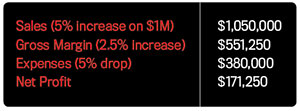Small adjustments in sales, margins and expenses can yield big results for your bottom line.
Talk of improving your bottom line by a set percentage each year can seem like a challenging yardstick for many business owners. What if you could achieve your hoped-for result — say, 10 percent growth — without increasing any single area of your business by that amount? Rather than focusing on increasing your total sales by 10 percent, you instead aim to increase the variables that make it up by a smaller percentage each. Let’s break down the typical store performance.
Last year, Jan achieved sales of $1 million yielding a gross profit at keystone of $500,000. After expenses of $400,000, she is left with a net profit of $100,000 for the year. If Jan wants to increase her profit by 10 percent to $110,000, does she need to increase her sales by 10 percent? Not necessarily.
There are a number of factors that make up Jan’s profit:
- Her sales
- Her margins
- Her expenses
Any change in these factors, whether positive or negative, will affect her profit. If Jan wants to grow her business, she needs to positively change these variables. Let’s illustrate her options:
Scenario 1. Jan can increase her sales by 10 percent while maintaining her margins. If she has a corresponding increase in expenses (from $400,000 per year to $440,000), she will achieve 10 percent growth in net profit.
Scenario 2. Jan can improve her margins. Keystone gives her a gross profit of $500,000. Assuming she can control her expenses at $400,000 again, an increase in her gross profit to $510,000 will achieve her objective. To do this, she only needs to improve her margins by 4 percent to succeed at lifting her net profit by the 10 percent required.
Advertisement

Scenario 3. Jan maintains sales and margins but cuts costs. A drop in her expenses by just 2.5 percent (from $400,000 to $390,000) will see her achieve her 10 percent increase in net profit.
Breaking down the goal into each of these objectives makes it far more manageable. If Jan can achieve each of these changes simultaneously, what affect would it have? If Jan increases her margins by 4 percent and reduces her expenses by 2.5 percent, then the effect is cumulative and she will see a 20 percent increase in her net profit. If she managed to achieve a 5 percent increase in sales, a 2.5 percent increase in gross margin and a 5 percent drop in expenses, Jan’s figures would look like this (see figure at left). The end result of a small improvement in each of these areas is a huge 71 percent increase in profit achieved.
David Brown is president of the Edge Retail Academy, an organization devoted to the ongoing measurement and growth of jewelry store performance and profitability. For more information about the Academy’s management, mentoring and industry benchmarking reports, contact inquiries@edgeretailacademy.com or call (877) 569-8657.
This article originally appeared in the February 2017 edition of INSTORE.
Advertisement